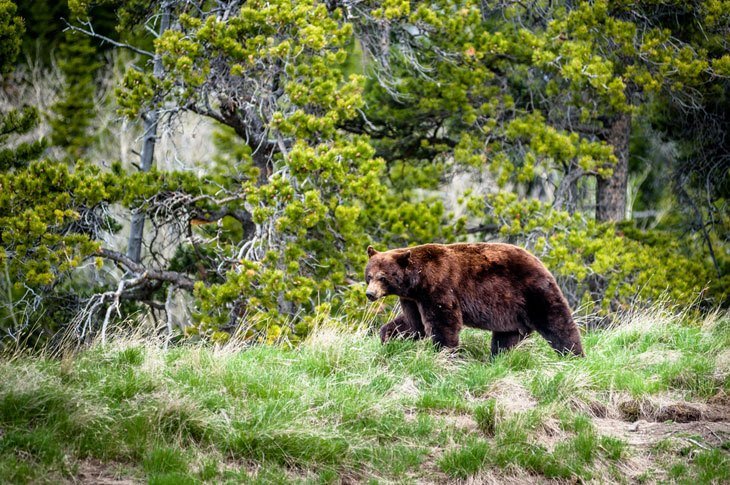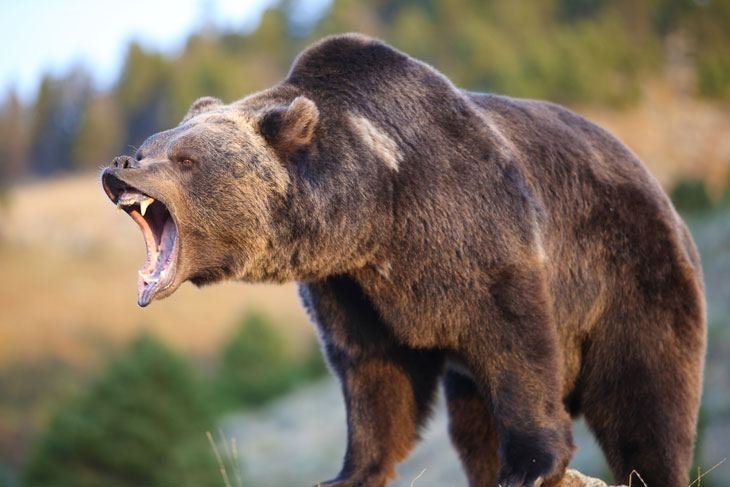One of the best things about spending time in the wilderness is the chance to see wildlife in its natural environment – and seeing a bear in the wild can be a truly exhilarating experience.
However, many people have an understandable fear of bears. Are you properly informed to make sure encounters with bears occur safely and in the right circumstances? Do you know what to do if something goes wrong? I’m here to help you!
Table of Contents
Don’t Attract Bears To Your Camp

While seeing a wild bear from a safe distance can prove to be a memorable moment, you certainly don’t want a bear to come snooping around your camp uninvited. Bears have an excellent sense of smell, even better than dogs, so you need to take care not to attract them.
This means you should prepare and store food correctly using bear resistant containers or a bear hang. Change your clothes after cooking and never cook in your tent. It is a good idea to store cooking utensils and clothes worn for cooking at least 100m from where you sleep.
Bears have impressive memories and once they learn that campsites are sources of food, they will associate humans with feeding. This means that for your own safety as well as that of others after you, you should take every precaution not to attract bears to your camping area.
Learn about the Main Types Of Camping
Bears At A Distance

If you are lucky enough to catch sight of a bear in the wild at a safe distance, you need to know how to behave correctly. Bears generally avoid humans and as long as you leave them enough personal space, it is unlikely you will encounter any problems.
First of all, keep your distance. If the bear is unaware of your presence, the most important points to remember are that you should not draw attention to yourself and, above all, you should not attempt to approach the bear.
In this situation, the safest thing to do is to turn around and head back the way you came or, if this is not possible, move around the bear leaving it plenty of space.
Closer Contact – Defensive Behavior

Bears are unlikely to become aggressive but some of the reasons for them to do so are if they are protecting cubs or food, if they are startled or if they feel trapped. To avoid startling a bear, it is advisable to make plenty of noise while you are hiking.
Check out this Bear Bell with magnetic silencer rings warning of your presence to bears and other animals.
It is also recommended to hike in groups. Groups tend to make more noise so a bear will be able to hear you coming and will be able to move away. Larger groups are also more intimidating to bears and are much less likely to be attacked than solitary hikers.
If you do suddenly come face to face with a bear, the first and most important thing to do is remain calm and assess the situation. Begin talking in a steady voice and slowly wave your arms up and down to identify yourself clearly as a human and not a prey animal.
At this point you should prepare your bear spray if you are carrying any and be ready to use it. For a guide on when and how to use bear spray, click here.
It is most likely the bear is as keen as you are to find a peaceful way out of the encounter. A defensive bear may make noises, growl, puff, blow or swat the ground with its paw. The bear may also make bluff charges but stop at the last moment.
A Bluff Charge? Watch these videos:
Don’t make eye contact but at the same time keep watching the bear and back away slowly. If the bear doesn’t follow you, continue to back away until you can’t see the bear any longer and then leave the area.
Remember, a bear that rears onto its hind legs or even approaches you is not necessarily being aggressive, it is probably being curious and wants a better look or wants to smell you.
In this case, talk firmly to the bear and move out of the way. If it follows you, stand your ground. Showing weakness at this point may initiate predatory behavior.
Closer Contact – Predatory Behavior

If you suspect the bear is not demonstrating defensive behavior, then your reaction should be different. The cues to look for are a lack of noise, ears pointing forward, or if the bear keeps its attention focused on you and follows you while you try to back away.
If you are convinced the bear is in predatory mode, you should act assertively and aggressively. Make yourself big, make lots of noise, take a step towards the bear, look it in the eyes and, in short, let the bear know that if it attacks you, you are going to fight back.
If The Bear Attacks

If the bear carries through with a physical attack, you need to try to be aware of two things. The first is the species of bear and the second is the bear’s intentions. This information will help you decide how to act.
Black bears are more shy than brown bears and are more likely to retreat in a confrontation. This means if you are attacked by a black bear, it is more likely to be a predatory attack.
Brown bears are more likely to attack when feeling threatened so if you are attacked by a brown bear, it is less likely to be an attempt at predation.
In the event of an attack by a black bear, the generally accepted advice is that you should NEVER play dead. Be prepared to fight back in any way you can to preserve your life using sticks, stones, or kicking. You should aim your attacks at the bear’s eyes or nose.
Having a boot knife can help you in this situation.
If you are attacked by a brown bear, unless you have reason to believe that the attack is predatory, your first course of action should be to play dead. Stretch out on your stomach with your hands on your head and protect your neck with your arms.
You should spread your legs wide to stop the bear flipping you over. If the bear manages to flip you over, roll back over onto your stomach again a resume the previous position. If you have a backpack on, it may provide a small amount of extra protection.
If the attack appears to be more prolonged and determined, you will have to prepare to defend yourself as the bear is engaging in a predatory attack. In this case, you need to do everything you can to fight back, again aiming for the sensitive eyes and nose and using anything available.
If you are confronted by a polar bear, you must assume the bear is predatory and you must prepare yourself to fight for your life. Polar bears are always hungry and will actively hunt humans given the chance. Playing dead with a polar bear will not save you.
Conclusion
Attacks by bears on humans are extremely rare and fatal attacks even more so. There is no reason to have an excessive fear of bears but before you set off on a hike into bear country it is necessary that you understand what to do in various situations.
With the correct information and the proper respect, you should be able to camp safely and experience these magnificent animals without ever putting yourself or others in danger.
If you meet a bear:
Do
- Stay calm
- Assess the behavior and intentions of the bear
- Make note of the species you are facing
- Decide on the correct course of action accordingly
Never
- Run
- Scream
- Act suddenly or unpredictably in a way that may cause the bear to attack
By the way, check out this video of how calm this guy is when a bear comes up and sits down right next to him!
What do you think? Do you have any questions or comments? Have you ever seen a bear in the wild? We’d love to hear your feedback!
